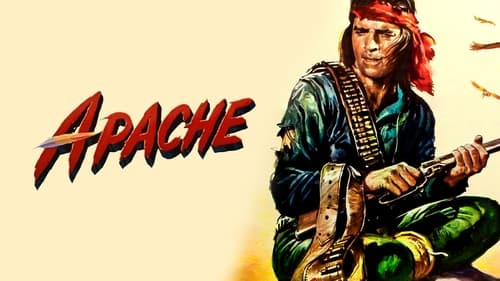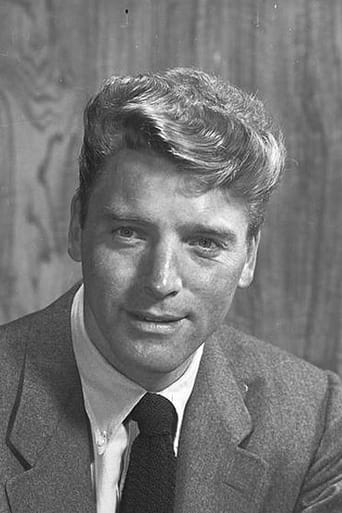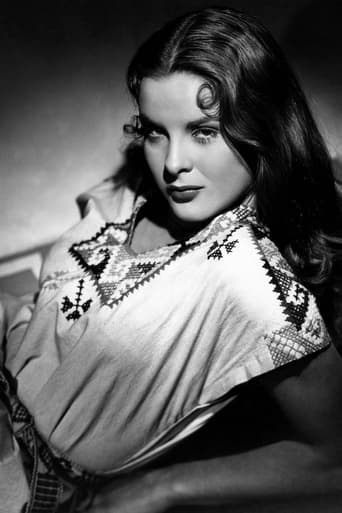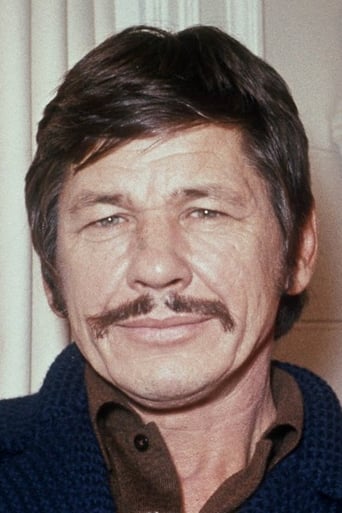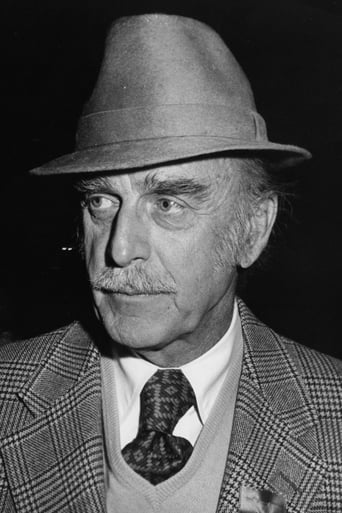Senteur
As somebody who had not heard any of this before, it became a curious phenomenon to sit and watch a film and slowly have the realities begin to click into place.
Griff Lees
Very good movie overall, highly recommended. Most of the negative reviews don't have any merit and are all pollitically based. Give this movie a chance at least, and it might give you a different perspective.
Nicole
I enjoyed watching this film and would recommend other to give it a try , (as I am) but this movie, although enjoyable to watch due to the better than average acting fails to add anything new to its storyline that is all too familiar to these types of movies.
Guillelmina
The film's masterful storytelling did its job. The message was clear. No need to overdo.
Wuchak
RELEASED IN 1954 and directed by Robert Aldrich, "Apache" is based on the real-life story of Massai (Burt Lancaster), a Chiricahua Apache who was exiled with other Apaches to a reservation in Florida to be held with Geronimo and Chihuahua, but he escapes the train somewhere near St. Louis and travels 1200 miles back to the Mescalero Apache tribal area, conducting one-man raids near what is now the Arizona-New Mexican border. John McIntire plays the chief of scouts commissioned to capture Massai while Charles Bronson (Buchinsky) is on hand as an Apache scout. Jean Peters plays an Apache babe who, in real life, was Zanagoliche.Massai actually escaped the prison train with a Tonkawa Native named Gray Lizard and they traveled the long journey back by foot together, eventually parting company in Southeastern Arizona. Gray Lizard is, unfortunately, completely omitted in the film.To enjoy this movie you have to look past Lancaster in the lead role or, at least, imagine him to look more like a real Apache. But, keep this in mind: Since Massai is the sympathetic protagonist of the story the movie would've never been made in the early 50s without a known Hollywood star playing the role. Why? Simple: Producers needed to attract viewers in order for the film to make money. Actually, Lancaster isn't too unbelievable in the role, as long as you can disregard his blue eyes. Unfortunately babelicious Peters looks way too European to play an Apache squaw, even though they tried to hide it by darkening her skin. On the positive side, there are a lot of real Natives in peripheral roles.The whole first act is great as Massai is a fish-out-of-water in the city of St. Louis. Unfortunately there are dull stretches in the second and third acts. Nevertheless, "Apache" was better than I thought it would be and inspired me to look up the real-life Massai. It was also a hit at the box office despite falling into relative obscurity since then. The score is surprisingly bearable for an old Western."Apache" made Native Americans (who aren't really 'native' since their ancestors emigrated from Asia) sympathetic characters in cinema, along with earlier Westerns, like "Buffalo Bill" (1944), "Fort Apache" (1948) and "Broken Arrow" (1950) and later Westerns, like "The Last Wagon" (1956), "A Man Called Horse" (1970) and "I Will Fight No More Forever" (1975).THE FILM RUNS 1 hours & 31 minutes and was shot in California, Arizona and New Mexico. WRITERS: James R. Webb wrote the script based on Paul Wellman's novel.GRADE: B-
Spikeopath
Apache is directed by Robert Aldrich and adapted to screenplay by James R. Webb from the novel "Broncho Apache" written by Paul Wellman. It stars Burt Lancaster, Jean Peters, John McIntire, John Dehner, Charles Bronson and Paul Guilfoyle. Music is by David Raksin and cinematography by Ernest Laszlo."This is the story of Massai, the last Apache warrior. It has been told and re-told until it has become one of the great legends of the Southwest. it began in 1886 with Geronimo's surrender."Apache has problems, undoubtedly, from the casting of overtly bright eyed Americans in the principal Native American roles, to the shift into love story territory, and on to the studio enforced compromised ending, it's a mixed bag for sure. If you can get over these "issues" then there is still a lot to enjoy here. You're not a warrior any more; you're just a whipped Injun.Apache follows in the footsteps made by Broken Arrow and Devil's Doorway that saw a shift in how Native Americans were being represented on screen. The story of Massai (Lancaster) is a fascinating one, even if the movie doesn't quite be all that it can be. It shows him as a stoic and complex individual, fiercely determined in a last man standing type of way, while his confusion with the world he no longer understands - or cares to be part of - is expertly realised by Lancaster and Aldrich. One sequence has Massai walk through town observing the alien white man world at work, including Chinese folk busying themselves in a laundry, it's a smart piece of writing, proving that there is intelligence and points of worth in the story.You are like a dying wolf biting at its own wounds.Thankfully the film doesn't go too far the other way and paint Massai as a saint, we know what he is capable off, and he shows us his skills as a warrior as the story moves on. There's even a scene of major manhandling of Nalinle (Peters) that is uncomfortable viewing but actually integral to Massai's emotional state and how the story between the two unfolds. Here in is the problem, once Massai and Nalinle "fall" for each other the picture loses its edge, where even though Aldrich inserts some more action sequences, the grit, intelligence and narrative thrust has disappeared. This all leads to the ending, that as written originally should have seen a cold and dark finish along the lines of the brilliant Devil's Doorway. Instead we get something approaching cuteness and not as profound as the studio obviously thought it was.The casting of Lancaster and Peters gives the film athletic muscularity and beauty (respectively), certainly in Lancaster's case he throws himself into a role he actively courted to take him onto another acting level (he co-produced it with Harold Hecht). It takes some getting used to, but they provide wholesome characterisations even if they never convince as Native Americans. Support work from McIntire and Dehner is strong, but unfortunately Bronson (here billed as Buchinsky) is short changed by a screenplay that doesn't enhance a very promising character. Raksin's score blends the usual Indian thrums with a love theme that is not dissimilar to the love theme used by Alex North for Spartacus six years later. While Laszlo's Technicolor photography is grade "A" stuff where the landscapes (a number of locations were used, primarily in California) form a telling part of the plotting. Problems for sure here, and in truth it's the weakest Western made by the Aldrich/Lancaster pairing, but it has good strengths, it was a financial success and it's a story well worth being told. 7/10
nvilar
Apache is one of the first Hollywood films which dealt in a serious, thought-provoking and openly sympathetic way with the suffering of the native Americans as a consequence of the white man's expansion to the West. It is interesting to watch this film side by side with, for instance, John Ford's silent classic The Iron Horse, as we can see two opposite approaches to the history of the American West in the late 19th century. While Ford's epic production is a hymn to white man's progress and to the expansion of civilization to the wild, unexplored territories of the United States inhabited by the Indian nations, Apache is a touching drama about the desperate fight for survival of those same Indians, who were ruthlessly driven out of their ancestral lands and ways of life by the stern advance of material progress. The plight of the Apache nation is embodied by the central character of the film, the strong, stubborn, freedom-loving and nobly human Indian warrior Massai, played by the actor Burt Lancaster, who was also the inspirer and producer of the film. Unwilling to accept personal slavery and what he deems as the total humiliation of his nation after Chief Geronimo's surrender to the U.S. Army and the confinement of the Apache tribes to the reserve, Massai decides to start a one-man fight for human dignity and freedom and becomes a solitary outlaw at war with the local U.S. Army garrison.The film is certainly worth watching, not only because of the human interest of the story itself, but also as a well-crafted piece of cinema. Apache is the first great movie by the director Robert Aldrich, who in that year of 1954 would score double and reward us with another masterpiece, the unforgettable Veracruz, also with a Burt Lancaster in absolute state of grace as an actor, this time teaming with the veteran Gary Cooper.If in Veracruz Lancaster gave as a memorable performance as the attractive villain Joe Erin, here he is no less powerful as the honest and indomitable warrior Massai. At his side, also good performances by Jean Peters in the role of the faithful, ever-loving and determined squaw Nalinle, and John McIntire as the hard-boiled, cynical Indian-hunter Al Sieber, in a role that prefigures the twilight heroes of Peckinpah's films.All in all, a classic of the Western genre which inaugurated Aldrich's later shining career.
James Hitchcock
Like "Broken Arrow", which came out four years earlier, "Apache" deals with the Apache Wars of the late nineteenth century and is loosely based on fact. It is, however, set at a rather later period of history than the earlier film. Geronimo, the last Apache chief to continue to resist the white settlement of the American South-West has finally been forced to surrender to the US Army. (Geronimo played a minor role in "Broken Arrow" as the main opponent of Cochise's peace treaty with the whites). Geronimo and his warriors are transported by train to a reservation in Florida. While they are passing through St Louis, however, one warrior, Massai, manages to escape and sets out to walk all the way to back his homeland.Another similarity between this film and "Broken Arrow" is that both are made from a point of view sympathetic to Native Americans. Indeed, "Apache" goes further than the earlier film in this respect. In "Broken Arrow" the main Indian character, Cochise, and the main white character, Tom Jeffords, are both treated sympathetically and are given equal prominence. Here Massai is very much the most important character, more prominent than any of the white characters, none of whom are particularly sympathetic. A key scene in the film comes when Massai, on his long trek back to the South-West, meets a Comanche farmer in Oklahoma. Hitherto Massai, like all Apaches, has seen himself as a proud hunter and warrior, scorning all those, be they whites or members of other Indian tribes, who earn a living by growing crops. Seeing, however, that the Comanche live in peace with their white neighbours, he reasons that a similar change of lifestyle could enable the Apache to do the same. Upon his arrival back in the Apache homelands, however, he discovers that the white settlers and the military have no intention of allowing him to live in peace, and he begins a one-man war against them. As in "Broken Arrow" the main Indian characters, Massai and his wife Nalinle, are played by white actors, something which would today doubtless be condemned as politically incorrect but which in the fifties would have been regarded as quite acceptable. Burt Lancaster may have been attracted to the part by his liberal political convictions which were to become more important in his choice of roles later in his career. It must be said, however, that Lancaster is far less convincing as an Indian than Jeff Chandler had been in "Broken Arrow"; no attempt was made to hide the fact that both he and his co-star Jean Peters had blue eyes, something not normally associated with pure-bred Apaches. Another Indian character is played by a white actor, a young Charles Bronson in an early role. This was not, in fact, the first film in which Lancaster had played an American Indian; three years earlier he had played the title role in "Jim Thorpe- All American". Thorpe, however, although a member of the Sac and Fox nation, had European blood on both sides of his family, so Lancaster's looks were not such an issue in that film. "Apache" is a frequently enjoyable Western adventure, but I would not rate it as highly as "Broken Arrow". Whereas "Broken Arrow" had tried to present a more balanced picture of life in the Old West than many traditional Westerns, which had simply portrayed Native Americans as bloodthirsty savages, "Apache" goes too far in the other direction, substituting for the old stereotype a new one of the American Indian as heroic noble savage. Burt Lancaster gets a chance to show off the athletic and acrobatic skills which were his stock-in-trade during the early part of his career, but this is not really one of his best performances or one of his best films. 6/10



